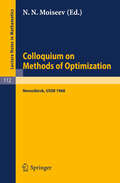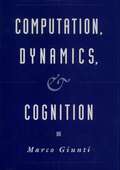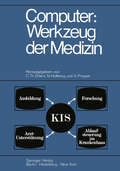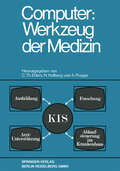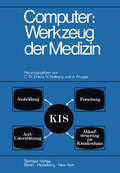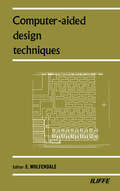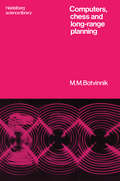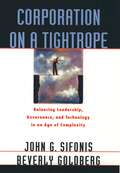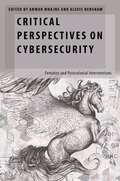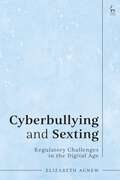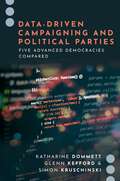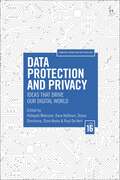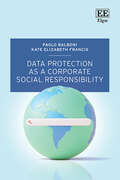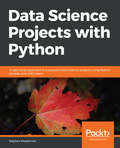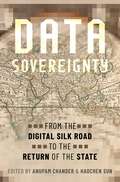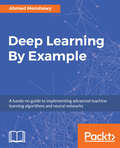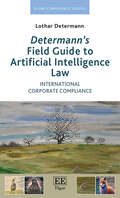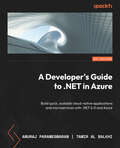- Table View
- List View
Cambridge International AS Level Information Technology Student's Book Second Edition
by Graham Brown Brian SargentOur AS Level student book is endorsed by Cambridge International Education to support the full syllabus for examination from 2025.Develop theoretical and practical IT skills with this comprehensive Student's Book written by experienced authors and examiners specially for the updated Cambridge International Education AS Level Information Technology syllabus (9626).- Improve understanding of concepts and terminology with clear explanations, labelled illustrations, photographs, diagrams, plus a glossary of key terms- Develop theoretical and practical skills with a range of exercises (multi choice through to discussion type questions), exam-style questions, step-by-step instructions and example answers that all ensure skills are developed alongside knowledge- Follow a structured route through the course with in-depth coverage of the full syllabusAlso available in the series:Cambridge International AS Level Information Technology Student Book eBook 9781036005597Cambridge International AS Level Information Technology Skills Workbook 9781510483064
Clean Code with C#: Refactor your legacy C# code base and improve application performance using best practices
by Jason AllsEnhance your programming skills through code reviews, TDD and BDD implementation, and API design to overcome code inefficiency, redundancy, and other issues arising from bad codeKey FeaturesWrite code that seamlessly integrates with other systems while maintaining well-defined software boundariesUnderstand how coding principles and standards elevate software qualityLearn how to avoid common errors while implementing concurrency or threadingPurchase of the print or Kindle book includes a free PDF eBookBook DescriptionTraditionally associated with Windows desktop applications and game development, C# has expanded into web, cloud, and mobile development. However, despite its extensive coding features, professionals often encounter issues with efficiency, scalability, and maintainability due to poor code. Clean Code in C# guides you in identifying and resolving these problems using coding best practices. This book starts by comparing good and bad code to emphasize the importance of coding standards, principles, and methodologies. It then covers code reviews, unit testing, and test-driven development, and addresses cross-cutting concerns. As you advance through the chapters, you’ll discover programming best practices for objects, data structures, exception handling, and other aspects of writing C# computer programs. You’ll also explore API design and code quality enhancement tools, while studying examples of poor coding practices to understand what to avoid. By the end of this clean code book, you’ll have the developed the skills needed to apply industry-approved coding practices to write clean, readable, extendable, and maintainable C# code.What you will learnMaster the art of writing evolvable and adaptable codeImplement the fail-pass-refactor methodology using a sample C# console applicationDevelop custom C# exceptions that provide meaningful informationIdentify low-quality C# code in need of refactoringImprove code performance using profiling and refactoring toolsCreate efficient and bug-free code using functional programming techniquesWrite cross-platform code using MAUIDevelop cloud-deployable microservices for versatile applicationsWho this book is forThis coding book is for proficient C# developers, team leads, senior software engineers, and software architects who want to improve the efficiency of their legacy systems. A strong understanding of C# programming is assumed.
Colloquium on Methods of Optimization: Held in Novosibirsk/USSR, June 1968 (Lecture Notes in Mathematics #112)
by N. N. MoiseevComputation, Dynamics, And Cognition
by Marco GiuntiCurrently there is growing interest in the application of dynamical methods to the study of cognition. Computation, Dynamics, and Cognition investigates this convergence from a theoretical and philosophical perspective, generating a provocative new view of the aims and methods of cognitive science. Advancing the dynamical approach as the methodological frame best equipped to guide inquiry in the field's two main research programs--the symbolic and connectionist approaches--Marco Giunti engages a host of questions crucial not only to the science of cognition, but also to computation theory, dynamical systems theory, philosophy of mind, and philosophy of science. In chapter one Giunti employs a dynamical viewpoint to explore foundational issues in computation theory. Using the concept of Turing computability, he precisely and originally defines the nature of a computational system, sharpening our understanding of computation theory and its applications. In chapter two he generalizes his definition of a computational system, arguing that the concept of Turing computability itself is relative to the kind of support on which Turing machine operate. Chapter three completes the book's conceptual foundation, discussing a form of scientific explanation for real dynamical systems that Giunti calls "Galilean explanation." The book's fourth and final chapter develops the methodological thesis that all cognitive systems are dynamical systems. On Giunti's view, a dynamical approach is likely to benefit even those scientific explanations of cognition which are based on symbolic models. Giunti concludes by proposing a new modeling practice for cognitive science, one based on "Galilean models" of cognitive systems. Innovative, lucidly-written, and broad-ranging in its analysis, Computation, Dynamics, and Cognition will interest philosophers of science and mind, as well as cognitive scientists, computer scientists, and theorists of dynamical systems. This book elaborates a comprehensive picture of the application of dynamical methods to the study of cognition. Giunti argues that both computational systems and connectionist networks are special types of dynamical systems. He shows how this dynamical approach can be applied to problems of cognition, information processing, consciousness, meaning, and the relation between body and mind.
Computer: Kolloquium Datenverarbeitung und Medizin 7.–9. Oktober 1968 Schloß Reinharthausen in Erbach im Rheingau
by C. Th. Ehlers N. Hollberg A. ProppeComputer: Kolloquium Datenverarbeitung und Medizin 7.–9. Oktober 1968 Schloß Reinhartshausen in Erbach im Rheingau
by C. Th. Ehlers N. Hollberg A ProppeComputer: Kolloquium Datenverarbeitung und Medizin, 7. – 9. Oktober 1968 Schloß Reinhartshausen in Erbach im Rheingau
by Carl Th. Ehlers N. Hollberg A. ProppeComputer-Aided Design Techniques
by E. WolfendaleComputer-aided Design Techniques deals with the tools used in computer-aided design, problems associated with software development for design, and techniques applied in the development of the REDAC system. The book covers topics such as program design, requirements of a program for general use, and representation of the circuit in a computer; device modeling, general linear modeling, and linear and non-linear transistor modeling; and non-linear transient analysis. Also covered are topics such as layout capacitances and inductances computation; the use of graphic display as a drawing aid for circuit layout; and the writing of design programs. The text is recommended for engineers and physicists who would like to know how computers can aid them in design, as well as computer experts who aim to write programs intended for design.
Computers, Chess and Long-Range Planning (Heidelberg Science Library)
by Michail M. BotvinnikMihail Moiseevich Botvinnik is an electrical engineer by profession; during World War II he headed a high-tension laboratory in the Urals and was decorated by the USSR for his accomplishments. At present, he is the head of the alternating-current machine laboratory at the Moscow Institute of Power Engineering. He is also a world-renowned chess player. He was born in 1911, and by 1935 had become a Grandmaster of Soviet chess. In 1948 he won the world chess championship and held the title until 1963 (except for a two-year break). His chess style has been characterized as deep, objective, serious, and courageous. In this book, the quality of his thinking is revealed in his study of the basic thought processes of master chess players, and his reduction of these processes to mathematical form. This formalization of thought processes is a contribution to science at three levels: at the immediate level, it provides a basis for a computer program that seems likely to succeed in playing chess; at the middle level, game-playing programs help us to study and rationalize the processes of planning and decision-making; and, at the highest level, the study of the mind in action, as in the game of chess, leads to an understanding of human thought and of the human psyche.
Containers for Developers Handbook: A practical guide to developing and delivering applications using software containers
by Francisco Javier UreaEffortlessly create and manage complex multi-component applications based on Docker containersKey FeaturesGain a clear understanding of software containers from the SecDevOps perspectiveMaster the construction of application pieces within containers to achieve a seamless life cyclePrepare your applications to run smoothly and with ease in complex container orchestratorsPurchase of the print or Kindle book includes a free PDF eBookBook DescriptionDevelopers are changing their deployment artifacts from application binaries to container images, giving rise to the need to build container-based apps as part of their new development workflow. Managing an app’s life cycle is complex and requires effort—this book will show you how to efficiently develop, share, and execute applications. You’ll learn how to automate the build and delivery process using CI/CD tools with containers as container orchestrators manage the complexity of running cluster-wide applications, creating infrastructure abstraction layers, while your applications run with high availability, resilience, and persistence. As you advance, you’ll develop, test, and debug applications on your desktop and get them ready to run in production with optimal security standards, using deployment patterns and monitoring tools to help identify common issues. You’ll also review deployment patterns that’ll enable you to solve common deployment problems, providing high availability, scalability, and security to your applications. Finally, you’ll explore different solutions to monitor, log, and instrument your applications as per open-source community standards. By the end of this book, you’ll be able to manage your app’s life cycle by implementing CI/CD workflows using containers to automate the building and delivery of its components.What you will learnFind out how to build microservices-based applications using containersDeploy your processes within containers using Docker featuresOrchestrate multi-component applications on standalone serversDeploy applications cluster-wide in container orchestratorsSolve common deployment problems such as persistency or app exposure using best practicesReview your application’s health and debug it using open-source toolsDiscover how to orchestrate CI/CD workflows using containersWho this book is forThis book is for developers and DevOps engineers looking to learn about the implementation of containers in application development, especially DevOps engineers who deploy, monitor, and maintain container-based applications running on orchestrated platforms. In general, this book is for IT professionals who want to understand Docker container-based applications and their deployment. A basic understanding of coding and frontend-backend architectures is needed to follow the examples presented in this book.
Corporation On A Tightrope: Balancing Leadership, Governance, And Technology In An Age Of Complexity
by John G. Sifonis Beverly GoldbergCracking the Data Engineering Interview: Land your dream job with the help of resume-building tips, over 100 mock questions, and a unique portfolio
by Kedeisha Bryan Taamir RansomeGet to grips with the fundamental concepts of data engineering, and solve mock interview questions while building a strong resume and a personal brand to attract the right employersKey FeaturesDevelop your own brand, projects, and portfolio with expert help to stand out in the interview roundGet a quick refresher on core data engineering topics, such as Python, SQL, ETL, and data modelingPractice with 50 mock questions on SQL, Python, and more to ace the behavioral and technical roundsPurchase of the print or Kindle book includes a free PDF eBookBook DescriptionPreparing for a data engineering interview can often get overwhelming due to the abundance of tools and technologies, leaving you struggling to prioritize which ones to focus on. This hands-on guide provides you with the essential foundational and advanced knowledge needed to simplify your learning journey. The book begins by helping you gain a clear understanding of the nature of data engineering and how it differs from organization to organization. As you progress through the chapters, you’ll receive expert advice, practical tips, and real-world insights on everything from creating a resume and cover letter to networking and negotiating your salary. The chapters also offer refresher training on data engineering essentials, including data modeling, database architecture, ETL processes, data warehousing, cloud computing, big data, and machine learning. As you advance, you’ll gain a holistic view by exploring continuous integration/continuous development (CI/CD), data security, and privacy. Finally, the book will help you practice case studies, mock interviews, as well as behavioral questions. By the end of this book, you will have a clear understanding of what is required to succeed in an interview for a data engineering role.What you will learnCreate maintainable and scalable code for unit testingUnderstand the fundamental concepts of core data engineering tasksPrepare with over 100 behavioral and technical interview questionsDiscover data engineer archetypes and how they can help you prepare for the interviewApply the essential concepts of Python and SQL in data engineeringBuild your personal brand to noticeably stand out as a candidateWho this book is forIf you’re an aspiring data engineer looking for guidance on how to land, prepare for, and excel in data engineering interviews, this book is for you. Familiarity with the fundamentals of data engineering, such as data modeling, cloud warehouses, programming (python and SQL), building data pipelines, scheduling your workflows (Airflow), and APIs, is a prerequisite.
Critical Perspectives on Cybersecurity: Feminist and Postcolonial Interventions (Oxford Studies in Gender and International Relations)
Traditional notions of national security have generally dominated cybersecurity debates, but the response to emerging cybersecurity issues should not merely focus on the militarization of cyberspace. Weaponizing a space heavily populated by civilians has enormous implications for human rights. Yet, cybersecurity studies in international relations have largely overlooked the impact of cybersecurity policies on individuals and communities--including the consequences of surveillance, data overcollection, cybercrime, and cyberbullying. Critical Perspectives on Cybersecurity offers a new approach to understanding cybersecurity in international relations. As a counterpoint to existing work, which focuses largely on the security of states, private actors, and infrastructure, chapter authors examine how women and communities across the Global South understand "cybersecurity," including what threats and forms of resistance are most important to them. They make the case that policies need to consider individual human rights by putting people's empowerment and wellbeing at their center. Drawing on feminist and postcolonial theory, the chapters also cover issues that challenge conventional notions of cybersecurity, including disinformation, gender-based violence online, and technology as a neocolonial force. Bringing together contributions from a globally diverse range of authors, Anwar Mhajne and Alexis Henshaw provide a human security perspective on cybersecurity that pays attention to the interplay of race, ethnicity, gender, class, and other social hierarchies, especially regarding cybersecurity in the Global South.
Cyberbullying and Sexting: Regulatory Challenges in the Digital Age
by Dr Elizabeth AgnewDrawing on two empirical studies and influential theoretical frameworks, this book provides a critical overview of the key regulatory challenges concerning cyberbullying and sexting behaviours among young people (persons under 18 years).The author explores issues such as conceptualising the behaviours, examining the prevailing presence of sexism, myths and stereotypes surrounding gender roles and identity, and the limitations of criminal law as an effective regulatory tool. In doing so, identifying peer-based sexting behaviours as part of a continuum of sexual behaviour is promoted alongside the need to consider interventions beyond the legal landscape and in line with the United Nations Convention on the Rights of the Child. In the main, priority is given to non-legal responses and the need for more effective and comprehensive gender-sensitive education programmes. The book therefore provides a more developed conceptual understanding of sexting and cyberbullying behaviours among young people.
Data-Driven Campaigning and Political Parties: Five Advanced Democracies Compared (Journalism and Political Communication Unbound)
by Katharine Dommett Glenn Kefford Simon KruschinskiWhat is data-driven campaigning? According to prevailing accounts, this idea describes the rise of increasingly sophisticated, highly targeted, and often invasive uses of data deployed to suppress votes, manipulate voter preferences, or boost a candidates' popularity. The power of data is seen to be transforming campaigning practice and raising democratic concerns. And yet, there is a significant problem with these ideas: we have at best a partial understanding of how data-driven campaigning is practiced, and limited clarity about its implications. Presenting data from interviews with over 300 professional campaigners in Australia, Canada, Germany, the UK and US, we provide unique insight into the components of data-driven campaigning by political parties. This book makes three key contributions. First, distinguishing between data, analytics, technology and personnel, they give unmatched descriptive insight into these four components of data-driven campaigning, revealing significant variation in its operationalization, depending on party and country context. Second, introducing a novel multi-level theoretical framework, they isolate systemic, regulatory, and party level variables that help explain the reasons for these differences. Third, they consider the implications of their findings for debates about democracy, data and technology in the 21st century. Cumulatively, these contributions reveal that data-driven campaigning is not inherently problematic. Giving voice to practitioner perspectives, through interviews and innovative vignettes, this book recasts the debate around data-driven campaigning, offering important lessons for scholars, campaigners, and policymakers alike.
Data Labeling in Machine Learning with Python: Explore modern ways to prepare labeled data for training and fine-tuning ML and generative AI models
by Vijaya Kumar SudaTake your data preparation, machine learning, and GenAI skills to the next level by learning a range of Python algorithms and tools for data labelingKey FeaturesGenerate labels for regression in scenarios with limited training dataApply generative AI and large language models (LLMs) to explore and label text dataLeverage Python libraries for image, video, and audio data analysis and data labelingPurchase of the print or Kindle book includes a free PDF eBookBook DescriptionData labeling is the invisible hand that guides the power of artificial intelligence and machine learning. In today’s data-driven world, mastering data labeling is not just an advantage, it’s a necessity. Data Labeling in Machine Learning with Python empowers you to unearth value from raw data, create intelligent systems, and influence the course of technological evolution. With this book, you'll discover the art of employing summary statistics, weak supervision, programmatic rules, and heuristics to assign labels to unlabeled training data programmatically. As you progress, you'll be able to enhance your datasets by mastering the intricacies of semi-supervised learning and data augmentation. Venturing further into the data landscape, you'll immerse yourself in the annotation of image, video, and audio data, harnessing the power of Python libraries such as seaborn, matplotlib, cv2, librosa, openai, and langchain. With hands-on guidance and practical examples, you'll gain proficiency in annotating diverse data types effectively. By the end of this book, you’ll have the practical expertise to programmatically label diverse data types and enhance datasets, unlocking the full potential of your data.What you will learnExcel in exploratory data analysis (EDA) for tabular, text, audio, video, and image dataUnderstand how to use Python libraries to apply rules to label raw dataDiscover data augmentation techniques for adding classification labelsLeverage K-means clustering to classify unsupervised dataExplore how hybrid supervised learning is applied to add labels for classificationMaster text data classification with generative AIDetect objects and classify images with OpenCV and YOLOUncover a range of techniques and resources for data annotationWho this book is forThis book is for machine learning engineers, data scientists, and data engineers who want to learn data labeling methods and algorithms for model training. Data enthusiasts and Python developers will be able to use this book to learn data exploration and annotation using Python libraries. Basic Python knowledge is beneficial but not necessary to get started.
Data Protection and Privacy, Volume 16: Ideas That Drive Our Digital World (Computers, Privacy and Data Protection)
This book explores the complexity and depths of our digital world by providing a selection of analyses and discussions from the 16th annual international conference on Computers, Privacy and Data Protection (CPDP): Ideas that Drive Our Digital World. The first half of the book focuses on issues related to the GDPR and data. These chapters provide a critical analysis of the 5-year history of the complex GDPR enforcement system, covering: codes of conduct as a potential co-regulation instrument for the market; an interdisciplinary approach to privacy assessment on synthetic data; the ethical implications of secondary use of publicly available personal data; and automating technologies and GDPR compliance.The second half of the book shifts focus to novel issues and ideas that drive our digital world. The chapters offer analyses on social and environmental sustainability of smart cities; reconstructing states as information platforms; stakeholder identification using the example of video-based Active and Assisted Living (AAL); and a human-centred approach to dark patterns.This interdisciplinary book takes readers on an intellectual journey into a wide range of issues and cutting-edge ideas to tackle our ever-evolving digital landscape.
Data Protection as a Corporate Social Responsibility
by Paolo Balboni Kate FrancisThis progressive book critically analyses the current state of data protection enforcement and proposes a new auditable framework of practical guidelines to contribute to a more sustainable data-driven future.In outlining the debates relating to current data protection structures, Paolo Balboni and Kate Elizabeth Francis argue that legislation alone cannot sufficiently protect individuals’ fundamental rights and freedoms, and instead consider the pressing need for a more ethical approach to data protection. They present the Maastricht University Data Protection as a Corporate Social Responsibility Framework (UM-DPCSR Framework), outlining not only its features, but also how it can fill the gap left by the inadequacies of a merely legal approach to data protection. Balboni and Francis persuasively call on organisations wishing to contribute positively to society through data processing to adopt this framework and to commit to doing good with data or, at the very least, to avoid harming individuals by processing their data.Data Protection as a Corporate Social Responsibility will be a beneficial read for scholars and students with particular interest in corporate law and governance, human rights, internet and technology law, and privacy. It will also appeal to legal professionals, cybersecurity professionals, and sustainability specialists alike.
Data Science Projects With Python: A Case Study Approach To Successful Data Science Projects Using Python, Pandas, And Scikit-learn
by Stephen KlostermanData Sovereignty: From the Digital Silk Road to the Return of the State
Who, if anyone, should regulate the internet? Governments around the world have answered this question robustly: they will. Data sovereignty-the exercise of control over the internet-is the ambition of world leaders as a natural extension of traditional sovereignty and as a bulwark against the reach of foreign power. The question posed to governments now is not who should regulate the internet, but how should it be done. Data Sovereignty: From the Digital Silk Road to the Return of the State focuses on the question of territorial control over data flows and attempts by national and regional governments to place limits on the free movement of data across a global internet. Drawing on theories in political economy, international law, human rights, and data protection, this volume offers new theoretical perspectives and thought-provoking ideas about the nature and scope of data sovereignty. It examines the extent to which new technologies, such as artificial intelligence, robotics, and automation, pose challenges to data sovereignty and how those challenges might be addressed. In chapters that are both descriptively comprehensive and analytically rich, the book explains the national, regional, and international legal frameworks for regulating the digital economy. Professors Anupam Chander and Haochen Sun have assembled a distinguished team of experts across multiple fields to address the promise and pitfalls of data sovereignty in the context of trade liberalization, data localization, and human rights protection. In a world that is still grappling with the scope of the internet, Data Sovereignty offers a timely and thorough investigation of the ongoing conflict between the state and the internet. This is an open access title available under the terms of a CC BY-NC-ND 4.0 International licence. It is free to read on Oxford Scholarship Online and offered as a free PDF download from OUP and selected open access locations.
Deep Learning By Example: A hands-on guide to implementing advanced machine learning algorithms and neural networks
by Ahmed MenshawyGrasp the fundamental concepts of deep learning using Tensorflow in a hands-on mannerAbout This BookGet a first-hand experience of the deep learning concepts and techniques with this easy-to-follow guideTrain different types of neural networks using Tensorflow for real-world problems in language processing, computer vision, transfer learning, and moreDesigned for those who believe in the concept of 'learn by doing', this book is a perfect blend of theory and code examplesWho This Book Is ForThis book targets data scientists and machine learning developers who wish to get started with deep learning. If you know what deep learning is but are not quite sure of how to use it, this book will help you as well. An understanding of statistics and data science concepts is required. Some familiarity with Python programming will also be beneficial.What You Will LearnUnderstand the fundamentals of deep learning and how it is different from machine learningGet familiarized with Tensorflow, one of the most popular libraries for advanced machine learningIncrease the predictive power of your model using feature engineeringUnderstand the basics of deep learning by solving a digit classification problem of MNISTDemonstrate face generation based on the CelebA database, a promising application of generative modelsApply deep learning to other domains like language modeling, sentiment analysis, and machine translationIn DetailDeep learning is a popular subset of machine learning, and it allows you to build complex models that are faster and give more accurate predictions. This book is your companion to take your first steps into the world of deep learning, with hands-on examples to boost your understanding of the topic.This book starts with a quick overview of the essential concepts of data science and machine learning which are required to get started with deep learning. It introduces you to Tensorflow, the most widely used machine learning library for training deep learning models. You will then work on your first deep learning problem by training a deep feed-forward neural network for digit classification, and move on to tackle other real-world problems in computer vision, language processing, sentiment analysis, and more. Advanced deep learning models such as generative adversarial networks and their applications are also covered in this book.By the end of this book, you will have a solid understanding of all the essential concepts in deep learning. With the help of the examples and code provided in this book, you will be equipped to train your own deep learning models with more confidence.Style and approachA step-by-step guide filled with multiple examples to help you get started with data science and deep learning.
Determann’s Field Guide to Artificial Intelligence Law: International Corporate Compliance (Elgar Compliance Guides)
by Lothar DetermannWith Determann’s Field Guide to Artificial Intelligence Law, readers can navigate a complex field traversing new technologies, business models, risks, rights, and legal issues. The author presents practical recommendations in a user-friendly and accessible format, designed to help organizations build and maintain their AI compliance and risk mitigation programs. A leading voice on data and technology law, Lothar Determann discusses existing and new laws pertaining to AI around the world and examines distinct advantages of different governance models.Key Features:Roadmap on how to identify, prioritize, and address risks and compliance obligationsChecklists, action items, and sample protocolsA-to-Z list of risks and mitigation measuresExamples of jurisdiction-specific legal requirementsGuidance on governance and accountability mechanismsPractitioners in corporate legal departments and private practice, compliance officers, programmers, privacy officers, data scientists, human resources (HR) specialists, and other professionals who must address AI and related legal compliance issues will find the guidance on risk assessments and mitigation, data law compliance, intellectual property, and other AI-related topics a vital resource.
A Developer's Guide to .NET in Azure: Build quick, scalable cloud-native applications and microservices with .NET 6.0 and Azure
by Anuraj Parameswaran Tamir Al BalkhiDevelop cloud-native applications using serverless technologies, Azure services, and .NET with the help of this reference guideKey FeaturesCreate cloud-native .NET applications using cutting-edge technologiesDesign, develop, and deploy scalable, manageable, and resilient apps with various Azure servicesExplore serverless architecture and optimize application scalability through efficient designPurchase of the print or Kindle book includes a free PDF eBookBook DescriptionA Developer’s Guide to .NET in Azure helps you embark on a transformative journey through Microsoft Azure that is tailored to .NET developers. This book is a curated compendium that’ll enable you to master the creation of resilient, scalable, and highly available applications. The book is divided into four parts, with Part 1 demystifying Azure for you and emphasizing the portal's utility and seamless integration. The chapters in this section help you configure your workspace for optimal Azure synergy. You’ll then move on to Part 2, where you’ll explore serverless computing, microservices, containerization, Dapr, and Azure Kubernetes Service for scalability, and build pragmatic, cost-effective applications using Azure Functions and Container apps. Part 3 delves into data and storage, showing you how to utilize Azure Blob Storage for unstructured data, Azure SQL Database for structured data, and Azure Cosmos DB for document-oriented data. The final part teaches you about messaging and security, utilizing Azure App Configuration, Event Hubs, Service Bus, Key Vault, and Azure AD B2C for robust, secure applications. By the end of this book, you’ll have mastered Azure's responsive infrastructure for exceptional applications.What you will learnDiscover how to create serverless apps and servicesDesign microservices with Azure Kubernetes serviceGet to grips with different Azure databases and storage servicesFind out how to use secret and configuration managementFamiliarize yourself with event-driven architectureUnderstand how to leverage Azure Service Bus and Azure Event HubsFind out how to protect APIs and apps using Azure B2CWho this book is forThis book is for .NET developers and architects who are eager to master the art of creating and deploying robust applications using .NET and Azure. A foundational understanding of .NET and Azure will enable you to enhance your skills with this resourceful guide. Developers aspiring to explore the realms of microservices and serverless applications within the .NET and Azure landscapes will find this book invaluable.
A Developer's Guide to .NET in Azure: Build quick, scalable cloud-native applications and microservices with .NET 6.0 and Azure
by Anuraj Parameswaran Tamir Al BalkhiDevelop cloud-native applications using serverless technologies, Azure services, and .NET with the help of this reference guideKey FeaturesCreate cloud-native .NET applications using cutting-edge technologiesDesign, develop, and deploy scalable, manageable, and resilient apps with various Azure servicesExplore serverless architecture and optimize application scalability through efficient designPurchase of the print or Kindle book includes a free PDF eBookBook DescriptionA Developer’s Guide to .NET in Azure helps you embark on a transformative journey through Microsoft Azure that is tailored to .NET developers. This book is a curated compendium that’ll enable you to master the creation of resilient, scalable, and highly available applications. The book is divided into four parts, with Part 1 demystifying Azure for you and emphasizing the portal's utility and seamless integration. The chapters in this section help you configure your workspace for optimal Azure synergy. You’ll then move on to Part 2, where you’ll explore serverless computing, microservices, containerization, Dapr, and Azure Kubernetes Service for scalability, and build pragmatic, cost-effective applications using Azure Functions and Container apps. Part 3 delves into data and storage, showing you how to utilize Azure Blob Storage for unstructured data, Azure SQL Database for structured data, and Azure Cosmos DB for document-oriented data. The final part teaches you about messaging and security, utilizing Azure App Configuration, Event Hubs, Service Bus, Key Vault, and Azure AD B2C for robust, secure applications. By the end of this book, you’ll have mastered Azure's responsive infrastructure for exceptional applications.What you will learnDiscover how to create serverless apps and servicesDesign microservices with Azure Kubernetes serviceGet to grips with different Azure databases and storage servicesFind out how to use secret and configuration managementFamiliarize yourself with event-driven architectureUnderstand how to leverage Azure Service Bus and Azure Event HubsFind out how to protect APIs and apps using Azure B2CWho this book is forThis book is for .NET developers and architects who are eager to master the art of creating and deploying robust applications using .NET and Azure. A foundational understanding of .NET and Azure will enable you to enhance your skills with this resourceful guide. Developers aspiring to explore the realms of microservices and serverless applications within the .NET and Azure landscapes will find this book invaluable.
Developing Extensions for Joomla! 5: Extend your sites and build rich customizations with Joomla! plugins, modules, and components
by Carlos M. MoraHarness the full potential of Joomla! through this comprehensive take on Joomla! extensions from conception through to releaseKey FeaturesDiscover the complete cycle of extension development from conception to releaseLeverage built-in features such as categories, ACL, and custom fields to enrich your extensionsLearn how to build extensions that integrate with the Joomla! API and the new Joomla! CLIPurchase of the print or Kindle book includes a free PDF eBookBook DescriptionJoomla! 5 is a groundbreaking CMS that helps you take a significant leap into the world of content management systems. Joomla! 5 features a variety of impressive new features that align with current web standards and enable you to experience lightning-fast performance for optimal web page optimization, leverage the new code architecture, and tap into the WebService API, among others. This book takes you on a journey of extending Joomla's capabilities by developing your own extensions. The chapters not only explain the key concepts behind Joomla's architecture but also equip you with the latest techniques for crafting components and plugins. You’ll discover how to leverage existing features within Joomla! to empower your extensions and create tailored solutions. The book takes you from the initial stages of planning your extension development to a fully featured finished product. As you advance, you'll learn invaluable techniques for testing your extension, addressing common issues, and preparing it for publication. The concluding chapters of this comprehensive guide teach you how to test your extension for common issues, along with how to publish the extension for everyone to use. By the end of this book, you’ll have the confidence and skills to complete the cycle of extension development.What you will learnFind out how to plan the development of a new extension from scratchUnderstand the basic structure of a Joomla! extensionGet to grips with the Joomla! Forms systemUse Joomla! features effectively to enrich your extensionsDiscover how to add a WebService API to your extensionCreate a Joomla! CLI command for your extensionDevelop a Joomla! Child Template for your projectsTest your extensions before the releaseWho this book is forThis book is for Joomla! developers and web designers who want to extend the functionalities of Joomla! and find innovative ways to customize their content management systems, e-commerce websites, business websites, and more. Basic familiarity with Joomla! will help you get the most out of this book.

